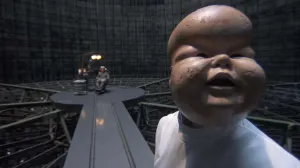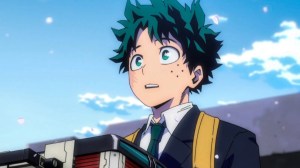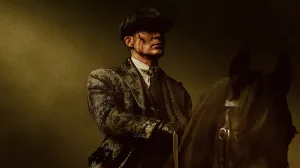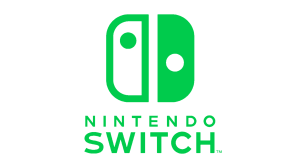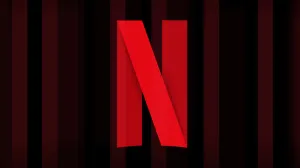While Patty Jenkins’ Wonder Woman wasn’t the DC Universe Easter egg bonanza that Batman v Superman: Dawn of Justice was, it certainly had quite a few moments lifted from the pages of the comics, recognizable characters and visuals, and more.
Videos by ComicBook.com

As we start to unpack everything that happened in the acclaimed solo film debut of Diana of Themyscira, it seemed like as good a time as any to try and unpack where all the Easter eggs and DC Comics references were, so we could see what, if anything, they might mean for the future of the Wonder Woman franchise or the future of her involvement with other DC superhero movies.
We’ll warn that there are spoilers on here, since some of the biggest Easter eggs come after Wonder Woman “learns the truth about herself” and becomes really Wonder Woman for the first time (although, like Man of Steel, we can’t remember anybody actually saying that name onscreen).
Check out what we spotted, and hit us up on Twitter @comicbook if you saw something we missed!
THE NEW 52
One major element of the movie that calls back to the comics calls back to…really recent comics.
That would be the 2011 “New 52” reboot, in which it was revealed that Wonder Woman wasn’t made from clay breathed to life by Zeus, but instead a demigod herself, the daughter of Zeus and Queen Hippolyta of the Amazons.
It was a major status quo shift that came after decades of her story being the other way in the comics — but while the “made from clay” origin is fairly well known to casual fans, it hasn’t had a major motion picture before, meaning that for many, the idea of Zeus as Wonder Woman’s father will likely be as definitive and pervasive as The Joker killing Thomas and Martha Wayne in Tim Burton’s Batman.
It frames the duality between Diana — driven by love and pursuing peace — and Ares, the god of war, in a very different light. Diana even acknowledges that, if only briefly, in the final battle as she launches herself and Ares and refers to him as “brother.”
That story also gave us the “War is truth” ethos and monologue that Ares delivered in the film, and several of the visuals, including the lightning-infused, almost-scary Wonder Woman floating in the air (although the “lightning attack” actually originated earlier, during the pre-Flashpoint run from Gail Simone).

DOCTOR POISON
Doctor Poison, a classic Wonder Woman villain who in the original comics dressed as a man to be taken seriously until she was “outed” as a woman, appears as a major antagonist in the film, although not much of that mythology remains intact.
In the film, Doctor Poison forgoes a traditional mask and goggles (although the goggles can be seen in a couple of scenes, they’re never worn in by Elena Anaya’s Dr. Maru in the film) in favor of a facial prosthetic. It has the effect of making her look alien and obscuring her “true” face, but it’s really used primarily to hide her disfigurement, a la Doctor Doom, rather than to hide her identity.
Worth a note that when working in her lab, “Doctor Poison” sometimes wears a green labcoat that feels like an homage to the comics (even if the bulky and andogynous labcoat was originally part of the move to hide her dressing as a man).

REAL-WORLD ENEMIES
The German armed forces in Wonder Woman are filled with real-world names and characters.
Erich Friedrich Wilhelm Ludendorff was a real German general in World War I, and (as indicated in the film) the commander of German forces near the end of the war — but he did not die in the closing days of the war as he does in Wonder Woman.
Instead, Ludendorff in real life lived until 1937, and was a prominent nationalist leader and conspiracy theorist, gaining popularity with working-class Germans by promoting a myth that claimed the German Army did not lose World War I on the battlefield but was instead betrayed by the civilians on the home front, especially the republicans who overthrew the monarchy in the German Revolution of 1918–19. The myth would become a key part of Nazi propaganda as Hitler ascended to power and in the run-up to World War II.
Explicitly referenced on lifeboats used by German soldiers in the film is the SMS Schwaben, a real-world German battleship that was commissioned in 1904 and decommissioned and scrapped in 1921.
An interesting bit of trivia about the Schwaben is that in 1905 it was used to replace a battleship called the Mars, which is of course the Roman name for the Greek god known as Ares.
Similarly, most of the set design is genuinely of the era, including recruitment and propaganda posters seen in the village outside of no-man’s-land.
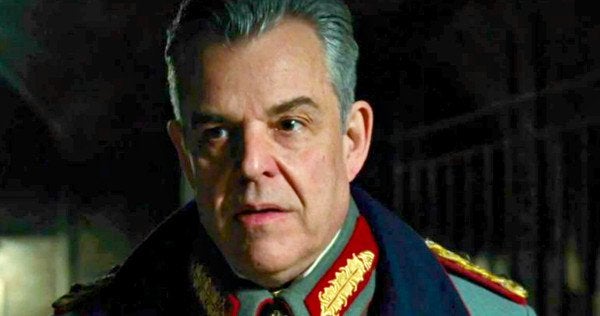
ARTEMIS
There are many familiar names on Themyscira, but probably the most notable one who isn’t a major character (and thus not really an “Easter egg,” per se) is Artemis.
Played by boxer Ann Wolfe, Artemis is often the warrior Wonder Woman has to square off against in a tournament for the right to head to Man’s World. That version of the origin didn’t come to the movie, and here Artemis is just an imposing fighter and an impressive force defending Themyscira when the Germans come chasing after Steve Trevor.
One interesting aspect of her presence in the film is that, in the ’90s, Artemis briefly held the role of Wonder Woman in the comics.
During the (recently-collected) William Messner-Loebs/Mike Deodato run on the series (something that gets a shout-out in the credits), Artemis came to man’s world in the Wonder Woman outfit, with Diana relegated to a black leather number.
This was around the same time we had the four “Supermen” replacing the Man of Steel after his death, Azrael as Batman, Connor Hawke as Green Arrow, and the death of the Green Lantern Corps, so superhero replacements were more or less par for the course at DC.

THEMYSCIRA
There’s a lot going on in Themyscira, even in the relatively short time we’re there, but it’s worth mentioning that several of the characters who appear there are familiar names to comic book fans.
The architecture is similarly appropriate, avoiding phallic imagery wherever possible in favor of a more rounded and “fluid” look.
The Lasso of Hestia, also known as the Lasso of Truth, also gets its origin from the comics, where it was crafted by Hestia, the Greek god of family and the hearth.
The Lasso functions much as it does in the comics, except that the “mind control” elements it’s sometimes depicted as having are basically gone, limited to the more traditional computsion to tell the truth.
We also get glimpses of life in Themyscira beyond just mythology, although they’re fairly few and far between, with most of the focus being on Diana’s story, which is gods, monsters, and combat training. Not that we don’t also learn about how men are necessary for procreation, but not for pleasure.
(Oh, yeah, and Steve calls it “Paradise Island,” which is what it was actually called for years in the comics before Themyscira was introduced as an official monker.)

ICE CREAM
While the film didn’t have a ton of time to slow down, that didn’t stop them from (mostly) adapting a story beat that took place in a more relaxed moment in the comics.
Following the New 52 reboot, Justice League was set in the past and explored the very first days after superheroes started to become “a thing.” One thing it played with — as we saw in the film — was Wonder Woman as a bit of a fish out of water.
And, yes, part of that was introducing her to the concept of ice cream — something she loved. It was a great little character moment from writer Geoff Johns and artist Jim Lee, both of whom are executives at DC and one of whom (Johns) had a hand in shaping the script.
If the scene seemed familiar from a movie perspective, it’s becuase it (along with the frist arc of Johns and Lee’s Justice League) was adapted in Justice League: War, an animated feature film in which, as in Wonder Woman, it’s Steve Trevor at Diana’s side when the scene takes place rather than a kid (as seen in the comic).

OUTFIT #226
When Diana is trying on clothes, we get a quip from Etta Candy that she’s experimenting with “outfit #226.”
That could be an arbitrary number chosen for comedy, but it seems less likely to be so when you consider that the final issue of Greg Rucka’s Wonder Woman run — and the final issue of the series which ran from shortly after the Crisis on Infinite Earths until 2006 — was #226.
The issue explored the character’s then-fraught relationship with Superman in the wake of Diana’s decision to kill Maxwell Lord.
You can get a digital copy of Wonder Woman #226 here, or check out the solicitaiton text below.
Final Issue! With the universe in turmoil, Diana prepares to face her ultimate challenge. As she considers her relationship with Superman from the way it began to its recent turmoil, will she find a way to rebuild what she’s lost?

ZACK SNYDER
While Zack Snyder didn’t direct this film, you can see elements of his visual aesthetic — established in Man of Steel and Batman v Superman: Dawn of Justice — all over the movie.
You can also — if you get lucky — spot SNYDER HIMSELF, who makes a cameo as an American soldier in the background as Wonder Woman and company cross No Man’s Land and retake Veld.

THE GODKILLER
The Godkiller concept gets a twist in Wonder Woman, of course, but that sword? Totally a part of the mythology…
…Deathstroke’s mythology, that is.
In DC Comics, The God Killer sword was given Slade Wilson/Deathstroke The Terminator as part of a contract the hitman took on. The mission was to kill a Greek Titan named Lapetus, which required The God Killer to accomplish.
The comic book version of The God Killer can shift its shape and weight, becoming other weapons like a bo staff or twin blades. It has crackling energy it can unleash in blasts, and is also semi-sentient, directing and/or controlling the wielder. It can also redirect any force inflicted upon it, two-fold (like a punch from Superman), and can reform itself if destroyed. As another major power, the sword can take a deity’s memories and transfer them into the wielder.

MORE WONDER WOMAN
Wonder Woman hits movie theaters around the world tonight when Gal Gadot returns as the title character in the epic action-adventure from director Patty Jenkins. Before she was Wonder Woman, she was Diana, Princess of the Amazons, trained to be an unconquerable warrior. Raised on a sheltered island paradise, when an American pilot crashes on their shores and tells of a massive conflict raging in the outside world, Diana leaves her home, convinced she can stop the threat. Fighting alongside man in a war to end all wars, Diana will discover her full powers…and her true destiny.
Wonder Woman is directed by Patty Jenkins and is written by Allan Heinberg, Geoff Johns, and Zack Snyder. The film stars Gal Gadot (Diana Prince/Wonder Woman), Chris Pine (Steve Trevor), Robin Wright (General Antiope), Connie Nielsen (Queen Hippolyta), David Thewlis, Elena Anaya, Lucy Davis (Etta Candy), Danny Huston, Ewen Bremmer, Doutzen Kroes, Samantha Jo (Euboea), Florence Kasumba (Senator Acantha), Said Taghmaoui, Eleanor Matsuura (Epione), Emily Carey (Young Diana), and Lisa Loven Kongsli (Menalippe).
The DCEU continues with Wonder Woman opens in theaters on June 2, 2017, followed by Justice League on November 17, 2017; Aquaman on July 27, 2018; Shazam on April 5, 2019; Justice League 2 on June 14, 2019; Cyborg on April 3, 2020; and Green Lantern Corps on July 24, 2020. The Flash, The Batman, Dark Universe and Man of Steel 2 are currently without a release dates.
Wonder Woman currently has a 4.11 out of 5 ComicBook User Anticipation Rating, making it the eighth-most anticipated upcoming comic book movie among ComicBook.com readers. Let us know how excited you are about Wonder Woman by giving it your own ComicBook User Anticipation Rating below!
More Wonder Woman news:
- How Wonder Woman Has Already Inspired Change
- Wonder Woman Director On Whether Diana Could Turn Away From Mankind
- Wonder Woman Debuts To Incredible Ratings On Rotten Tomatoes
- Wonder Woman Review: The Superheroine Movie Fans Deserve



